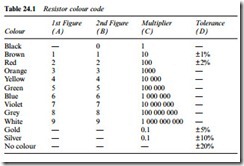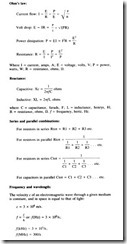CAPACITORS
Capacitors are most often printed directly with their value and working voltage. Colour coding systems are used, and differ according to
the type and shape of the device and the extent of information to be conveyed, though in all cases they use the same basic colour coding (Table 24.1) as for resistors, except for the 0.1 and 0.01 multipliers. Information typically given by colour coding includes value, temperature coefficient, tolerance and voltage rating. Since at least eight different coding systems have existed, and in many cases inspection does not reveal which of them is in use, it is impractical to give guidance here – the manufacturer’s service manual for the equipment must be consulted for details of the actual component in use, or the colour-code key.
SMD R and C codes
Not all SMDs are coded with their value, making it essential to keep them in their marked packs until they are used. Those that are coded use one of two systems in general use, which give resistor values in ohms and capacitor values in picofarads. The simplest is the three- symbol code, in which the first two digits give the base figure and the third the multiplier: thus 222 is 2.2 kΩ or 2200 pF; 153 is 15 kΩ or 15 000 pF; and 7R5 is 7.5 Ω. The alternative coding method consists of a letter and multiplier number, see Table 24.2. Here B2 indicates 110 Ω/110 pF, H4 20 kΩ/20 kpF etc.
where f is frequency and is λ wavelength in metres. Table 24.3 gives reference points for frequencies between 1 MHz and 3 GHz.

